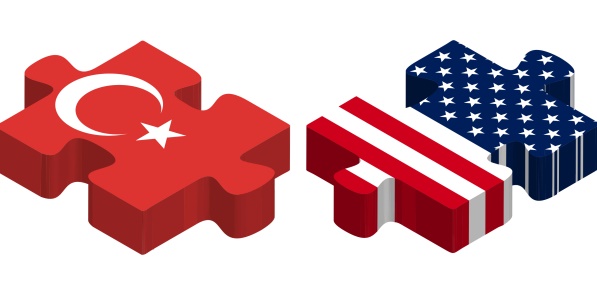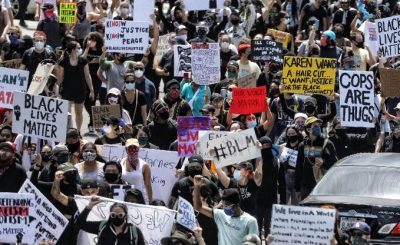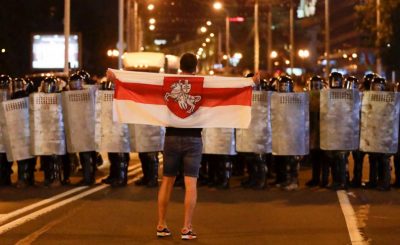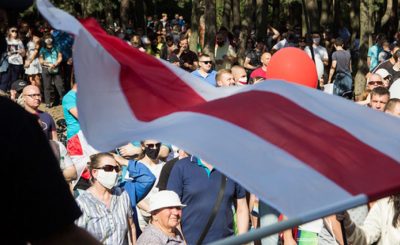We are godparents, partners by marriage, blood relatives.
Our villages, our nomad tents lie side by side.
For centuries we have taken daughters as wives and given daughters away We are neighbours, side by side Even our chickens mix with one another…”
Ahmet Arif
One of the main daily newspapers in Turkey has in its logo the words “Turkey belongs to the Turks”. And in the chauvinistic propaganda about the 75th anniversary of the republic’s foundation, we hear these words a great deal and no doubt will hear them a lot more in the coming months. But is it historically really the case? Does Turkey belong “exclusively” to the Turks?
Whoever has seen the various cities of Turkey or even has seen only the parts laid out for tourists can see right away that this does not correspond to the reality in Turkey. Yes, Anatolia is Turkish. But at the same time it is Kurdish. It is also a little bit Greek, a little bit Armenian, a little bit Arab, a little bit Cherkess (Circassian), a little bit Laz…
Anatolia has been the home of various peoples over millenia. Turks, Kurds, Arabs, Laz, Cherkess, Bosnians, Azeris and many other Muslim and Christian peoples have poured their sweat into Anatolia’s soil, cultivated it, derived produce from it as well as the most beautiful traditions and values.
The peoples living in Anatolia and the different faiths sometimes held by the same nationality, the different tribes and clans living in various regions have created their own values, traditions and cultures. From marriages to cultural festivals, to receiving visits from neighbours, from funerals to births, from day-to-day contacts to family structures, the differences among them are not difficult to detect. They are rooted in geography, religion or the economy.
But these cultural peculiarities were never an obstacle to the peoples living with each other in a fraternal manner amid mutual friendship, respect and tolerance. They lived together fraternally while maintaining their own cultural peculiarities. The mutual ties have also logically given rise to shared cultural characteristics. So for example, Kurdish and Arab influences can be detected in Turkish culture. The same applies to the cultures of the Kurds, Arabs and other peoples.
Even if the languages and religions of the peoples are different, they have still helped one another from time to time. Sometimes they were in neighbouring villages. In one area the villages are inhabited by Turkmen. But on another side of the same mountain there are Kurdish villages. If you then descend onto the plain, there are Arab villages…
The peoples are so mixed together. They invite each other to weddings and cultural festivals. At funerals, they pay condolence visits to one another.
Sometimes different nationalities live in the same village. The upper or lower side of the village, or even next door to each other. Together they celebrate festivals or share good and bad times.
The Sümela monastery is known to everybody, for example, even if only through television and the newspapers. While a ceremony is held in the church in keeping with its religion, the Muslims wait outside, sacrifice sheep and prepare for the festival. When the ceremony is over the Christians come out of the church. Turks, Laz, Georgians, Greeks, and Armenians celebrate…
Sheikh Bedreddin’s followers knew no distinctions of language, religion or nationality when they organised their life in Aydin, they shared everything, and everything was built through common effort and toil. In the face of the attacks from the Sultan and the rulers, they swung their swords together and the blood they all shed mingled.
Were relations between the peoples on the soil of Anatolia always like that, characterised by fraternity and tolerance? Unfortunately, no. Sometimes the peoples attacked each other and found the cruelest oppression to be appropriate. So, why was that the case? What destroyed the image of fraternity? What was it which would not let the peoples share among each other? Actually there is no “satisfactory” answer to this.
The rulers, from the Ottomans to the present day, have sought to secure their own domination by setting the peoples against one another. So they created artificial differences among them and sowed the seed of hostility. They organised provocations and exploited the beliefs of the peoples and with the help of their own religious leaders, religious law courts were established. Causing the effusion of another people’s blood was deemed to be righteous, and a place in paradise was said to be reserved for those who made blood flow.
If a people rose up against exploitation and oppression, the rulers sought to win over another people to help in putting down the uprising. Sometimes this was successful. For example Sunnis would be used to put down uprisings by Alevis, and Alevis would be massacred. In this way, Turks were armed against Kurds and hostilities fomented, and the same was done to cause discord between Kurds and Armenians, Armenians against Turks and Arabs against Greeks. For example, during the War of Liberation the imperialists tried to use the Armenians to break the resistance. As another example, the Kemalists used Alevi Kurds to defeat the uprising by Sheikh Said and the Sunni Kurdish tribes. During the First Imperialist War (World War I) Armenians were massacred. Hundreds of thousands of Armenians were murdered or forced to emigrate.
Not just to crush uprisings but for other reasons, the peoples would be stirred up against each other. Sometimes it was major landowners and feudal lords who incited the people so as to win the lands and riches that belonged to others.
As a result of this agitation, the provocations and massacres by the rulers have given rise to certain prejudices. Thus the Arabs are seen as dirty. They are disparagingly termed “fellahin”. On the other hand, Romanians are called “thieves”, and nobody will sit down next to them. Armenians and Greeks are “infidels”, the “historic enemy”. Kurds are “primitive”, the Laz are “stupid”, Turks are “oppressors”, “unbelievers”…
The rulers have intensified the “divide and rule policy” even further with capitalism and especially in the dissemination of news through the media. Based on the grandeur of the ruling nation, the rulers have made chauvinism into one of the cornerstones of their rule.
Fascism uses chauvinism by developing theories of the superiority of the Turkish race to create a mass base for itself. All other peoples are said to be enemies. On all sides there are enemies… “The only friends of the Turks are the Turks themselves.” It wants to use circles influenced by these chauvinist politics against other peoples or at least to educate them in such a way that they agree with the policy of the state and are against the struggle of the peoples.
But one of the biggest obstacles to the chauvinist politics and propaganda of fascism is the reality of the peoples in Anatolia.
Along with the development of capitalism, the peoples have more and more mingled and interwoven as part of the flight from the countryside to the cities. Today, especially in the biggest cities, people of every nationality and faith live together. They are neighbours in the same city quarters. They drop their sweat on the floors of the same factories. At school they share the same desks. They are ground down by the same oppression, exploitation and poverty and feel the same hunger pangs.
So we are asking who is responsible for the poverty and oppression experinced by the workers? Can the one who is responsible for the oppression for the pains suffered by a worker be a worker from another people who labours in the same factory? Of course not. Or if today languages, cultures and traditions of peoples are forbidden, are the Turkish people responsible for it? No they are not. The culture and traditions of the Turkish people too are threatened by the depraved imperialist culture. Attempts are made to destroy the ties between people, the values, the traditions, one after another. This is the common problem faced by all our peoples. The system is to blame for this. It is also the system which disseminates the corrupt imperialist culture, bans languages and cultures and exploits and oppresses the peoples.
On the other hand, the owners and rulers of this system are fundamentally neither Turks, Kurds nor Laz!
It is clear that this state belongs to none of the peoples of Anatolia. It is also not the state of the Turkish people, that is also clear. Whose state is it? Before everything else it is not the state of our peoples. This cannot be altered by its name, “Turkey” nor by the demagogy of “this state is the state belonging to us all, but there are separatists among us.”
Let us take a closer look at the rulers. Do they not come from all nationalities? Isn’t Sabanci a “Turk”? Isn’t Cefi Kamhi a “Jew”? Isn’t Sedat Bucak a “Kurd”? Isn’t Besim Tibuk a “Laz”? Are there not “Georgians”, “Azeris”, “Sunnis”, “Christians”, “Alevis” and “Armenians” among them? Yes there are. They have all formed a coalition. This is not a coalition of brotherhood, nor one of the unity of the peoples… This coalition is a coalition of exploiters, the dishonourable and the scoundrels. They sit at the helm of the treadmill, exploit our peoples, oppress and murder them.. Their religion, their beliefs, their nationality is “money”. To keep the system going they murder Turks just like Kurds. Or is that not the case?
It is our peoples who create and produce everything with the sweat from their brows. Can there really be underhandedness, rivalry and enmity among those who bring about everything through their sweat and their toil and who are the real possessors of all values and of everything that is beautiful? Not really. Hostility and oppression are merely the methods of those who want to lay hands on the fruits of this toil without working for it. Enmity, hypocrisy, separatism, provocations, massacres and every kind of filth are to be laid at their door.
It is in the interests of the peoples to put an end to repression. To end the suppression of identity, culture and language.
To drive out of the country this coalition of thieves who have sold the land to imperialism and their masters the imperialists, and to free the country.
One of the indispensible conditions for this is the unity of the peoples living in Anatolia and Thrace. Just like in the War of Liberation…
The place to achieve this is in the ranks of the Front. The Front is the unity and the common struggle of all our peoples. In the ranks of the Front all peoples struggle to bring about their own power. In the ranks of the Front, all people are free. Culture and identity are free and no people stands above another.
This power is the power of the people. Because only with people’s power can the culture and language of every people develop and be enriched. Under people’s power, the state has the duty to secure every opportunity for the peoples in this regard. In this state structure no peoples will stand over others or enjoy hegemony. Its basis is fraternity and friendship between the peoples. Setting up people’s power means securing a life in fraternity and freedom for all our peoples. The power of the people is the expression of the fact that all our peoples will share in the government that will resolve all economic, political, military, cultural and social questions. The power of the people is the liberation of the people.
The Front is convinced that Turkey is the Turkey of all the peoples who live in Anatolia and Thrace. The Front’s ranks are the ranks of the fraternity of all the peoples.
Hundreds of martyrs are the proof of this. Haydar, Sabo, Niyazi, Yemo… Kurds. Bedii, Gülnaz, Halil Ibrahim, Kemal, Berdan, Devrim Yasar… Arabs. Ali Tarik, Hasan, Murat, Mustafa, Idil, Müjdat… Turks. Sinan, Bahattin, Ayse… Laz. Osman, Ahmet Fazil, Arslan… Georgians. Avni, Ismet, Ümit Dogan… Cherkess.
They were members of the Central Committee, commanders, fighters in the ranks of the Front.
They came from different cultures, confessions and nationalities to meet in the ranks of the Front. To liberate the peoples, they fought with weapon in hand against the common foe. They shed their blood on Anatolia’s soil, and caused hope to grow.
The system is the enemy of our peoples. It is the system which divides the peoples and tries to oppress them, exploit them and has turned Anatolia into a prison. All peoples are brothers and this land belongs to them. The ranks of the Front show our peoples who is the enemy and who is the friend. On the other hand the struggle of the Front is the expression of freedom and the liberation of the peoples in this brotherhood and sisterhood.
Halk icin Kurtulus /Liberation for People / magazine, Number 93, August 8, 1998




